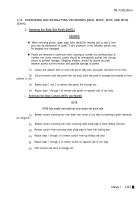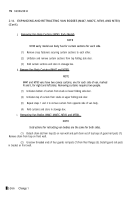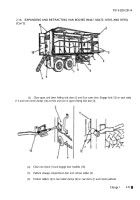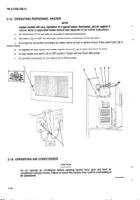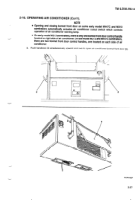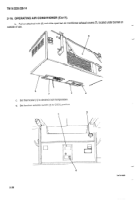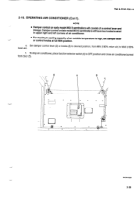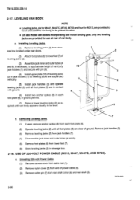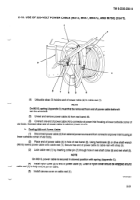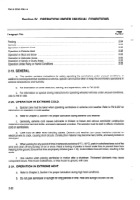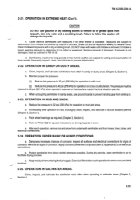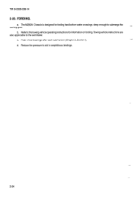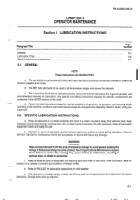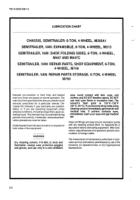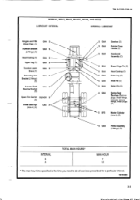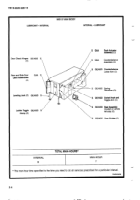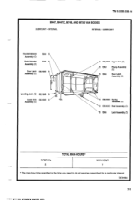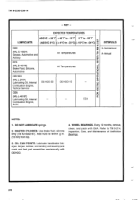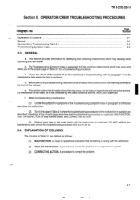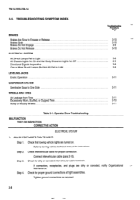TM-9-2330-238-14
CHASSIS, SEMITRAILER: 6-TON, 4-WHEEL M295A1; SEMITRAILER, VAN: EXPANSIBLE, 6-TON, 4-WHEEL M313; SEMITRAILER, VAN: SHOP, FOLDING SIDES, 6-TON, 4-WHEEL M447 AND M447C; SEMITRAILER, VAN: REPAIR PARTS, SHOP EQUIPMENT, 6-TON, 4-WHEEL M749; SEMITRAILER, VAN: REPAIR PARTS STORAGE, 6-TON, 4-WHEEL M750
TECHNICAL MANUAL; OPERATOR’S, ORGANIZATIONAL, DIRECT SUPPORT, AND GENERAL SUPPORT MAINTENANCE MANUAL
JULY 1992
TM-9-2330-238-14 - Page 85 of 462
TM
9-2330-238-14
2-21.
OPERATION
IN EXTREME
HEAT (Con’t).
CAUTION
DO
NOT
use
gasoline
or dry cleaning
solvent
to
remove
oil or grease
spots
from
tarpaulin.
Use
only water
and
a scrubbing
brush.
Failure
to follow
this caution
will
damage
the tarpaulin.
c.
Cover
inactive
semitrailers
with
tarpaulins
if no
other
shelter
is available.
Tarpaulins
are
subject
to
deterioration
from mildew
and attacks
by insects
or animals.
Shake
out and air tarpaulins
weekly
for several
hours.
Clean mildewed
tarpaulins
with a dry scrubbing
brush, DO NOT clean with water until mildew
is removed.
If mildew
is
found,
examine
tarpaulin
to determine
if it is rotted
or weakened.
Replace
tarpaulin
if damaged.
If tarpaulin
is not
damaged,
treat as outlined
in FM 10-16.
d.
Semitrailers,
inactive
for long periods
in hot, humid
weather,
are subject
to rusting
and accumulation
of
fungi
growth.
Frequently
inspect,
clean,
and lubricate
to prevent
deterioration.
2-22.
OPERATION
IN SANDY OR DUSTY AREAS.
a.
Clean,
inspect,
and lubricate
semitrailers
more often
in sandy
or dusty
areas
(Chapter
3, Section
I).
b.
Maintain
proper
tire pressure:
(1)
Reduce
tire pressure
to 32 psi (220 kPa) for operation
in soft sand.
(2)
Reduce
tire pressure
to 40 psi (276 kPa) for operation
on cross-country
terrain. Tire pressure
must be
returned
to 48 psi (331 kPa) when operation
resumes
on hard-surface
roads
if tactical
situation
permits.
c.
When
uncoupling
semitrailer
in sandy
areas,
use ground
boards
to prevent
landing
gear from sinking
in.
2-23.
OPERATION
IN MUD AND SNOW.
a.
Reduce
tire pressure
to 32 psi (220 kPa) for operation
in mud and snow.
b.
Immediately
after operation
in mud, thoroughly
clean,
inspect,
and lubricate
if tactical
situation
permits
(Chapter
3, Section
l).
c.
Pack wheel
bearings
as required
(Chapter
3, Section
l).
d.
Refer to FM 21-305 for special
instructions
on driving
hazards
in snow.
e.
After each operation,
remove
ice and snow from underneath
semitrailer
and from hoses,
lines, tubes,
and
electrical
connections,
2-24.
OPERATION
UNDER
RAINY OR HUMID
CONDITIONS.
a.
Dampness
increases
chances
of corrosion.
Inspect
all surfaces
and electrical
connections
for signs
of
corrosion.
Remove
all signs
of corrosion.
Apply
corrosion
preventive
compound
(Item 5, Appendix
E) to all electrical
connections.
b.
Protect
semitrailer
from
direct
rainfall
whenever
possible.
During
dry periods,
open
semitrailer
to air to
facilitate
drying
process.
c.
Keep moisture
from entering the fuel supply. Clean fuel filter before each operation
to remove accumulated
moisture.
2-25.
OPERATION
IN SALTWATER
AREAS.
Clean,
inspect,
and
lubricate
the
semitrailer
more
often
when
operating
in saltwater
areas
(Chapter
3,
Section
I).
2-33
Back to Top

